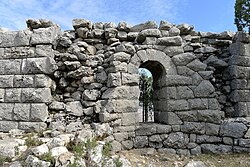| 𒃾𒅀𒉌𒌓𒉿𒀭𒁕 Wiyanawanda (Hittite) Οινόανδα (in Ancient Greek) | |
 The Greco-Roman theatre in Oenoanda The Greco-Roman theatre in Oenoanda | |
 | |
| Alternative name | Oinoanda |
|---|---|
| Location | İncealiler, Muğla Province, Turkey |
| Region | Lycia |
| Type | Settlement |
| History | |
| Associated with | Diogenes |


Oenoanda or Oinoanda (Hittite: 𒃾𒅀𒉌𒌓𒉿𒀭𒁕, romanized: Wiyanawanda, Ancient Greek: Οἰνόανδα) was a Lycian city, in the upper valley of the River Xanthus. It is noted for the philosophical inscription by the Epicurean, Diogenes of Oenoanda.
The ruins of the city lie on a high isolated site west of the modern village İncealiler in the Fethiye district of Muğla Province, Turkey, which partly overlies the ancient site.
The place name suggests that it was known for viticulture.
History
See also: Diogenes of OenoandaThe early history of the settlement is obscure, in spite of an exploratory survey carried out, with permission of the Turkish authorities, by the British Institute at Ankara (BIAA) in 1974–76.
The city was known as Wiyanawanda by the Hittites. It means "rich in vines/wine" or semantically "land of the wine". During the Bronze Age it was a part of the Lukka lands which corresponds to Lycia from classical antiquity.
It seems that Oenoanda became a colony of Termessos about 200-190 BC and was also called Termessos Minor (or Termessos i pros Oinoanda). Oenoanda was the most southerly of the Kibyran Tetrapolis, formed in the 2nd c. BC (Hellenistic Period), with Bubon, Balbura, and Kibyra which was dissolved by L. Licinius Murena in 84 BC, whereupon Oenoanda became part of the Lycian League, as its inscriptions abundantly demonstrate.
Diogenes, a rich and influential citizen of Oenoanda, had a summary of the philosophy of Epicurus carved onto a portico wall of the stoa showing the inhabitants the road to happiness. The inscription is one of the most important sources for the philosophical school of Epicurus and sets out his teachings on physics, epistemology, and ethics. It was originally about 25,000 words and 80 m long and filled 260 m of wall space. The inscription has been assigned on epigraphic grounds to the Hadrianic period, 117–138. The stoa was dismantled in the second half of the third century to extend the defensive wall.
It was occupied into the Byzantine period when a fortress and churches were built.
Oenoanda is a titular see of the Roman Catholic Church.
The Site

The site was first noted by Richard Hoskyn and Edward Forbes, in 1841, and published in 1842. The extensive philosophical inscriptions of Diogenes of Oenoanda were identified later from scattered fragments, apparently from the stoa.
The city walls are well preserved and stand to 10 m in places. The Hellenistic city wall is over 65 m long and is a superb example of polygonal masonry with small stones on the interior faces while large ashlars were used for the imposing exterior faces.
Part of an aqueduct can be seen in terms of stone pipe sections from a siphon.
Evidence for an ancient Roman Bridge at Oinoanda surfaced in the 1990s.
Official excavations at the site started only in 1997. New archaeological work was started in 2009 by the Deutsches Archäologisches Institut.
By 2012 over 300 fragments of Diogenes' stoa had been identified, varying in size from a few letters to passages of several sentences covering more than one block.
Remains of a screw wine press were also discovered in a house which could prove that the activity suggested in the place name continued to be practised into the late history of the city.
Notable people
- Lucius Septimius Flavianus Flavillianus (3rd century AD), Roman army member
References
- "The Oinoanda campaign of 2012 Archived 2013-07-01 at the Wayback Machine", German Archaeological Institute (DAI) website (accessed 27 June 2014)
- Alan Hall, "The Oenoanda Survey: 1974-76", Anatolian Studies 26 (1976:191-197).
- Özdemir, Bilsen Şerife (2016). Tlos Tanrıları ve Kültleri (PhD) (in Turkish). Akdeniz Üniversitesi. p. 13.
- Gander, Max (2014). "Tlos, Oinoanda and the Hittite Invasion of the Lukka lands. Some Thoughts on the History of North-Western Lycia in the Late Bronze and Iron Ages". Klio. 96 (2): 378. doi:10.1515/klio-2014-0039. S2CID 162386681.
- Rousset D., De Lycie en Cabalide, fouilles de Xanthos X, Droz, Genève 2010
- Strabo, xiii.4.17.
- Smith, Martin Ferguson (1996), The philosophical inscription of Diogenes of Oinoanda, Österreichische Akademie der Wissenschaften, pp. 43–8, ISBN 3-7001-2596-8
- Hall 1976:196.
- Catholic Hierarchy
- Hoskyn, Rd. (1842). "Narrative of a Survey of Part of the South Coast of Asia Minor; And of a Tour into the Interior of Lycia in 1840-1; Accompunied by a Map". Journal of the Royal Geographical Society of London. 12: 143–161. doi:10.2307/1797993. ISSN 0266-6235. JSTOR 1797993.
- C.W. Chilton, Diogenes of Oenoanda: The Fragments (1971); Hall 1976:196 note 23.
- "Oinoanda". Archived from the original on 2009-02-21. Retrieved 2009-06-29.
- N. P. Milner: "A Roman Bridge at Oinoanda", Anatolian Studies, 48 (1998), pp.117–123
- Excavations at Oinoanda 1997: The New Epicurean Texts, Martin Ferguson Smith, Anatolian Studies, Vol. 48 (1998), pp. 125-170, British Institute at Ankara, Cambridge University Press
- "Oinoanda". Archived from the original on 2009-02-21. Retrieved 2009-06-29.
- "The Oinoanda campaign of 2012 Archived 2013-07-01 at the Wayback Machine", German Archaeological Institute (DAI) website (accessed 27 June 2014)
External links
| Lycian League | |
|---|---|
| Votes: 3 | |
| Votes: 2 | - |
| Votes: 1 | |
| Votes: ? | |
| Associated locations | |
36°48′33″N 29°32′59″E / 36.80917°N 29.54972°E / 36.80917; 29.54972
Categories:- Populated places in ancient Lycia
- Ancient Greek archaeological sites in Turkey
- Archaeological sites in the Aegean region
- Roman towns and cities in Turkey
- Former populated places in Turkey
- Geography of Muğla Province
- History of Muğla Province
- Buildings and structures in Muğla Province
- Catholic titular sees in Asia